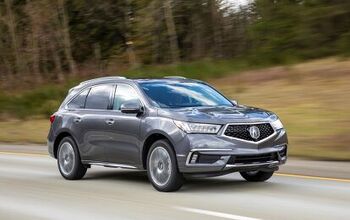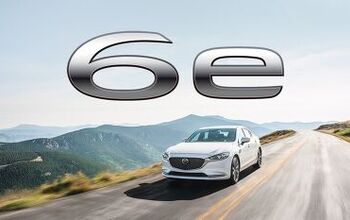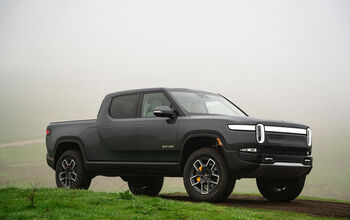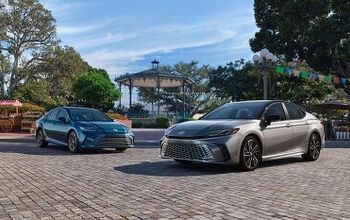Drag Racing a Sienna Against a Supra in the Snow is a Teachable Moment

Toyota has brought us to Calabogie, about an hour west of Canada’s capital, to sample a variety of its range in safe, easily-repeatable winter settings. Consider it a sequel to sister-brand Lexus’ Mosport-hosted activities last week, with a focus specifically on Toyota’s electric-AWD vehicles, including the Prius, RAV4, Sienna, and others. Of course, to highlight the strengths of that batch, they’ll have to go up against cars without the benefit of all-paw grip. Step forward then, Supra and 86.
SEE ALSO: 5 Winter Driving Tips From Driving Lexus Models at a Snowy TrackIt sounds silly, but there’s a method to the madness. The number of electrified models in the lineup has expanded in the last few years, as have AWD options. Toyota wants to address concerns about the e-AWD systems’ lack of physical driveshaft, to prove that for most everyday driving needs, even in Canadian winters, it’s up to the task. So to start the day, we head to the drag strip—in the least-powerful car here.
Snowy drag racing, for science
The Supra-versus-Sienna title fight has to wait. Up first in the red corner is the Prius AWD-e, an all-wheel drive version of the original Toyota hybrid. It produces just 121 horsepower, including a tiny electric motor capable of a whopping 7 hp. In the blue corner, a Toyota 86, the same one we drove last summer. It produces 205 hp, and is several hundred pounds lighter. Both cars are on the same winter rubber, so it’s going to walk me and the smiley Prius, right?
SEE ALSO: 2020 Toyota Prius AWD-e ReviewNope. Right from the start, the Prius has the edge on its sports-coupe sibling. That little magnetless electric motor out back produces up to 40 lb-ft of torque, and is active up to 6 mph (10 km/h) to help standing starts in slippery conditions just like these. From there until 43 mph (70 km/h), the AWD system is part-time, with the rear motor only waking up if the front detects slip. In contrast, the 86 can only let its traction control judiciously cut power to limit wheel spin. The near-perfect weight distribution that makes it such a joy in corners is its undoing here. There’s simply not enough weight over the driven wheels.
Sienna versus Supra, really
The Sienna is next. It looks enormous next to the Supra. It feels it too. For 2021, Toyota has switched the Sienna over to a hybrid drivetrain, and this tester features the optional AWD. At 245 hp it’s got over twice the power of the Prius, yet the Supra eclipses it with 382 hp. In the dry, this would be a blowout bigger than when the Cavs thrashed the Miami Heat 148–80 in 1991.
SEE ALSO: 2021 Toyota Sienna Review: First DriveYet, just like the last match-up, it’s the hybrid that pulls ahead. It’s an even bigger gap here, as the Supra is simply too powerful in this slushy setting. The safety nannies bog it down the whole way down the lane. Switch ’em off and the rear tires spin up if you even look at the right pedal wrong. You’ll feel the electronics reign the Sienna in at launch too, but the extra weight and driven axle allow it to find grip earlier and more consistently.
Through a slalom en route back to the starting line, the Sienna is quite tidy given its size. The minivan finds grip in more situations; the Supra requires monk levels of discipline with the throttle.
SEE ALSO: 2021 Toyota GR Supra A91 Edition Review: More Power, More Fun, More BlueThe morning lesson is plain to see: e-AWD adds an extra level of security for drivers in winter. Even when they’re on winter tires, rear-drive cars still only have one axle to translate power to forward motion. AWD makes standing starts more predictable in the white stuff, and in the case of the hybrids, that security comes with only a small penalty at the pumps.
Afterwards, Toyota puts us on a circular section with the 86 and Supra, with all aids off for maximum sideways action. It’s pure fun, a palate cleanser between tests. The snowy skid pan does highlight the inherent balance both sports cars have though, even if outright grip levels are low.
RAV4 flavors: FWD, AWD, and hybrids
For the next set of tests, the RAV4 is the star. The quartet covers the range, from a front-drive LE, AWD TRD Off-Road, an XSE Hybrid, and the plug-in Prime. We’ve got a longer straight-line run here, which then feeds into a short slalom.
SEE ALSO: 2020 Toyota RAV4 Hybrid Review: The Dependable OneIt makes sense to start with the front-driver as a baseline. It runs a 2.5-liter four-pot, with 203 hp and 184 lb-ft of torque. Needless to say, it can’t hope to keep up with the TRD off the line. Not only does the LE lack a second driven axle, but the TRD boasts a more robust torque-vectoring AWD system. The system can vary the amount of torque going to each rear wheel, which lets the RAV4 find the most grip it can in these quickly changing conditions. Even a half-second head start isn’t enough to secure a win for the LE.
The Hybrid versus TRD is the closest race of the day. The hybrid boasts an extra 14 total horsepower (up to 219), including the 53-hp rear electric motor, but it’s also lugging more weight. In action, it’s a matter of preference: the instant-on torque of the Hybrid’s electric motors is noticeable, while the TRD can apportion more of its total power to whichever axle needs it most. As the latter’s name suggests, it would eke out an advantage if you’re heading to a pavement-free zone. But everyday driving? There’s little between them. Most owners will find the Hybrid up to snuff, with fuel economy numbers about 50-percent better.
The Prime is easily the quickest, which is unsurprising given its 302 combined horsepower. You can run it in EV-only mode as well, which does slow it down considerably, but pays off with the quiet knowledge of emission-free motoring.
Through the slalom, it’s the LE that impresses, with the caveat of running on a constant throttle. It’s lighter, after all, and that lets it turn in sharply. Apply any sort of power, however, and it’s the other RAV4s that feel more secure, finding grip to put the power down and avoid dreaded understeer.
Quarry trail testing
For the final test of the day, every all-wheel drive model convoys out to an empty quarry outside the track. A hybrid Venza and Highlander join the fleet, as well as a hardcore 4Runner TRD Pro.
Needless to say, the 4Runner shrugs off everything the quarry throws at it. More surprising is how the more family-oriented vehicles handle the track. There are well-defined tracks by this point, but it’s still a choppy trail, with two big watering holes to plow through. The Prius ably climbs up and over the hills, though the low bumper does scoop up snow between the tracks. On the other end of the size spectrum, the Sienna shows even a minivan can handle light off-roading with ease. It feels secure, even when stopping and starting on a gravelly, slushy hill.
At the end of the day, there are still differences between electronic AWD and models with a physical driveshaft. Edge-case users will continue to seek out the latter for maximum capability, such as the 4Runner. But as Toyota continues to expand its electrified AWD offerings across all segments, buyers should be happy to know they can get most of the benefits, along with better fuel-efficiency.
Become an AutoGuide insider. Get the latest from the automotive world first by subscribing to our newsletter here.

Kyle began his automotive obsession before he even started school, courtesy of a remote control Porsche and various LEGO sets. He later studied advertising and graphic design at Humber College, which led him to writing about cars (both real and digital). He is now a proud member of the Automobile Journalists Association of Canada (AJAC), where he was the Journalist of the Year runner-up for 2021.
More by Kyle Patrick












































































































Comments
Join the conversation